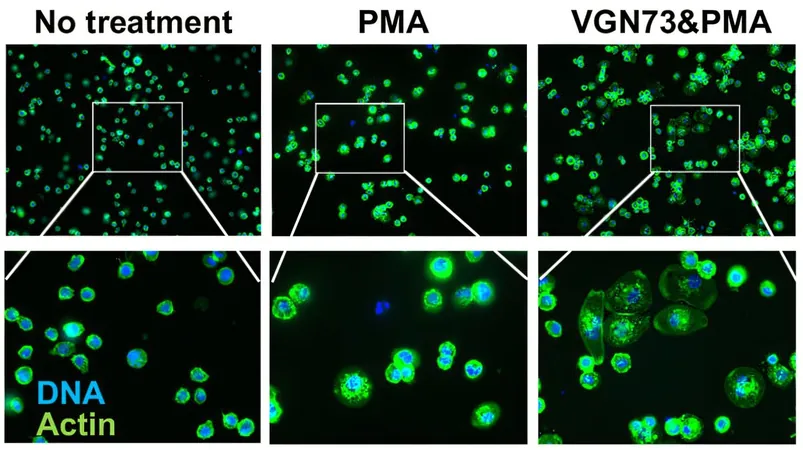
Unveiling the Secrets of Herpesviruses: A New Frontier in Cancer Treatment
2024-11-01
Author: Rajesh
Introduction
At the forefront of groundbreaking research at UC Davis Comprehensive Cancer Center is Yoshihiro Izumiya, a dedicated scientist grappling with the enigmatic interactions between viruses and their hosts. His tireless efforts focus on the intricate world of herpesviruses—dormant invaders that can awaken and unleash havoc, leading to serious health complications.
Herpesviruses stand out as common pathogens with over 100 identified types, eight of which primarily infect humans. This group includes well-known offenders like the herpes simplex viruses (types 1 and 2), Epstein-Barr virus, and Kaposi's sarcoma-associated herpesvirus (KSHV), which is notorious for its associations with certain skins cancers and immune disorders.
While many individuals carry these viruses silently, they can remain hidden for years only to spring to life unexpectedly, causing dire health problems. "Smart pathogens avoid causing obvious disease symptoms in their hosts to evade immune detection," Izumiya explains, emphasizing the sophisticated survival tactics these viruses employ.
From Dormancy to Danger: Understanding KSHV Activation
A key aspect of Izumiya’s research is probing into the KSHV, particularly surrounding its ability to switch from a dormant state to active replication. This virus is not just a simple pathogen; its genetic material, chromatin, can be perilously poised for reactivation under the right conditions.
The Izumiya Lab is investigating the precise triggers that provoke KSHV reactivation and the underlying mechanics that allow it to thrive in the host environment. "Decoding when and how KSHV begins replicating from its dormant chromatin is vital for developing targeted therapies," he states. The research aims to discern how inflammation in the body can influence the virus’s replication cycle, potentially leading to effective treatment options.
The Intricate Dance of Viral Manipulation
Herpesviruses like KSHV have ingeniously evolved to commandeer host cell machinery, thus enabling their own replication. Izumiya’s team has identified critical viral proteins involved in this hijacking process, which overrides the host's normal cellular functions to favor the production of viral proteins instead of the host’s messenger RNAs.
Through innovative research, they have discovered a strategy termed “reverse hijacking,” utilizing a small protein domain known as VGN50 that can mimic viral protein functions, allowing for control over transcription processes in host cells. The implication? By leveraging this mechanism, researchers hope to mitigate inflammatory responses linked to cancer progression.
In an exciting advancement, a peptide named VGN73 has been created that tricks the virus's mechanism to reduce the production of mRNA, a significant step toward curbing cancer cell growth. This promising research was recently highlighted in the journal *Cell Chemical Biology*.
Exploring Links Between Herpesviruses and Neurological Disorders
Izumiya’s exploration doesn’t end with KSHV. His lab is also delving into HHV-6A and HHV-6B, herpesviruses that infect individuals early in life and can integrate their viral DNA into human chromosomes. Such chromosomal integration raises concerns, as it may be linked to critical health issues, including brain inflammation and complications in pregnancy.
The challenge of studying inherited forms of HHV-6 is compounded by the lack of suitable models. To overcome this, Izumiya’s team is pioneering the use of induced pluripotent stem cells to create cellular models. By deriving stem cells from patients carrying iciHHV-6, the researchers aim to differentiate them into various cell types to understand how this viral persistence affects cellular behavior.
A Hopeful Horizon
Izumiya’s pioneering research stands to transform our understanding of both herpesviruses and their surprising relationship with cancer. By unraveling the complexities of these pathogens, Dr. Izumiya and his dedicated team are not only seeking to develop innovative therapies targeting herpes-related diseases but may also unlock new avenues in the fight against cancer. The innovative strategies born from studying one pathogen could potentially illuminate paths toward defeating others, reiterating the vital role of basic medical research in advancing our fight against diseases.
Stay tuned as this research continues to unfold, promising a new chapter in cancer therapeutics and viral treatment strategies that may change the landscape of medicine as we know it!



 Brasil (PT)
Brasil (PT)
 Canada (EN)
Canada (EN)
 Chile (ES)
Chile (ES)
 España (ES)
España (ES)
 France (FR)
France (FR)
 Hong Kong (EN)
Hong Kong (EN)
 Italia (IT)
Italia (IT)
 日本 (JA)
日本 (JA)
 Magyarország (HU)
Magyarország (HU)
 Norge (NO)
Norge (NO)
 Polska (PL)
Polska (PL)
 Schweiz (DE)
Schweiz (DE)
 Singapore (EN)
Singapore (EN)
 Sverige (SV)
Sverige (SV)
 Suomi (FI)
Suomi (FI)
 Türkiye (TR)
Türkiye (TR)